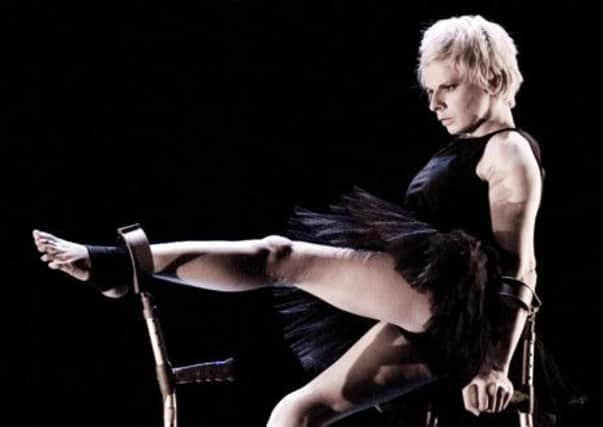Joyce McMillan: Art needs to be judged on its merits


And everywhere, on the walls, there are sudden images, animations, fragments of text; this is a technically complex show, with a production team of seven to support every performance.
Yet still, at the heart of it all, there stands a vulnerable human figure, small, female, blonde, with a fierce, womanly glamour. She is the dancer, singer, choreographer and theatre-maker Claire Cunningham; and she can move without the steel elbow-crutches that form a key visual element of the show, but not for long, and not very far. It’s her relationship with those crutches that lies at the heart of her 2012 show Ménage à Trois, developed over several years with support from the National Theatre of Scotland, and produced last year with funding from the Unlimited programme for projects led by people with disability, which came as part of the 2012 Cultural Olympiad.
Advertisement
Hide AdThe result is a magnificently powerful show, a Critics’ Award For Theatre In Scotland winner for the design and visual elements of the work, but also acclaimed for the blazing quality of the choreography, and of Cunningham’s performance with fellow-dancer Christopher Owen. The theme – expressed through a series of dream-like images, comic and tragic – is Cunningham’s sense of exclusion from the happy world of human love and touch; and although it deals with the sense of vulnerability and unattractiveness that she associates with her disability, those elements also evolve into a powerful metaphor for feelings of isolation, exclusion and unlovability that any human being might share.
The paradox is, though, that in creating a work of art so intensely personal in its inspiration, Cunningham has also generated a hot theatrical property; the show has already been seen in Glasgow, London, Belfast and Qatar, and formed a key part of this year’s Edinburgh Fringe Made In Scotland showcase at Paterson’s Land, where it attracted huge interest from the dozens of international programmers and promoters in town for the Festival. In the recent climate for arts funding – when artists have often felt fiercely pressurised to demonstrate that their work has some kind of immediate social or economic usefulness – it has been relatively easy for funding bodies to throw money at arts with the “disability” label, relatively difficult to make the case for mainstream work that treats art as a vital part of life for everyone, rather than a form of social work for disadvantaged groups.
If ever there was an artist intelligent and strong-minded enough to navigate these waters, though, it’s Cunningham. In her early 30s, she is proud of the way her work so far has managed both to contribute to the debate on disability in society while also achieving the highest artistic excellence, and delighting mainstream audiences. “I’m conscious of the danger of being used to tick boxes,” she says. “And there are probably places I wouldn’t go, because I just don’t think the artistic standards are high enough.
“In the end, though, I have to work from my own experience. And I’ve learned that if I do that, to the very best of my ability, then the show does reach out to people in a universal way, and begin to speak to everyone.”
And now, Cunningham is already working on her next project, partly funded via next year’s Commonwealth Games. Originally, it was supposed to be about landmines; but instead, it has developed a life of its own, and become a show about how different world faiths understand disability. Because in the end, Claire Cunningham is like all significant artists, in that she follows no agenda but her own; and in the expanding world of arts created by people with disability, that uncompromising sense of creative autonomy is a vital asset, in producing a body of work that seems to grow more impressive by the year.
Twitter: @joycemcm